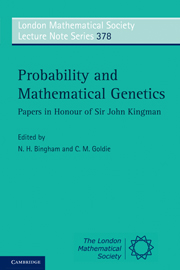Book contents
- Frontmatter
- Contents
- List of contributors
- Preface
- Bibliography of J. F. C. Kingman
- 1 A fragment of autobiography, 1957–1967
- 2 More uses of exchangeability: representations of complex random structures
- 3 Perfect simulation using dominated coupling from the past with application to area-interaction point processes and wavelet thresholding
- 4 Assessing molecular variability in cancer genomes
- 5 Branching out
- 6 Kingman, category and combinatorics
- 7 Long-range dependence in a Cox process directed by an alternating renewal process
- 8 Kernel methods and minimum contrast estimators for empirical deconvolution
- 9 The coalescent and its descendants
- 10 Kingman and mathematical population genetics
- 11 Characterizations of exchangeable partitions and random discrete distributions by deletion properties
- 12 Applying coupon-collecting theory to computer-aided assessments
- 13 Colouring and breaking sticks: random distributions and heterogeneous clustering
- 14 The associated random walk and martingales in random walks with stationary increments
- 15 Diffusion processes and coalescent trees
- 16 Three problems for the clairvoyant demon
- 17 Homogenization for advection-diffusion in a perforated domain
- 18 Heavy traffic on a controlled motorway
- 19 Coupling time distribution asymptotics for some couplings of the Lévy stochastic area
- 20 Queueing with neighbours
- 21 Optimal information feed
- 22 A dynamical-system picture of a simple branching-process phase transition
- Index
9 - The coalescent and its descendants
Published online by Cambridge University Press: 07 September 2011
- Frontmatter
- Contents
- List of contributors
- Preface
- Bibliography of J. F. C. Kingman
- 1 A fragment of autobiography, 1957–1967
- 2 More uses of exchangeability: representations of complex random structures
- 3 Perfect simulation using dominated coupling from the past with application to area-interaction point processes and wavelet thresholding
- 4 Assessing molecular variability in cancer genomes
- 5 Branching out
- 6 Kingman, category and combinatorics
- 7 Long-range dependence in a Cox process directed by an alternating renewal process
- 8 Kernel methods and minimum contrast estimators for empirical deconvolution
- 9 The coalescent and its descendants
- 10 Kingman and mathematical population genetics
- 11 Characterizations of exchangeable partitions and random discrete distributions by deletion properties
- 12 Applying coupon-collecting theory to computer-aided assessments
- 13 Colouring and breaking sticks: random distributions and heterogeneous clustering
- 14 The associated random walk and martingales in random walks with stationary increments
- 15 Diffusion processes and coalescent trees
- 16 Three problems for the clairvoyant demon
- 17 Homogenization for advection-diffusion in a perforated domain
- 18 Heavy traffic on a controlled motorway
- 19 Coupling time distribution asymptotics for some couplings of the Lévy stochastic area
- 20 Queueing with neighbours
- 21 Optimal information feed
- 22 A dynamical-system picture of a simple branching-process phase transition
- Index
Summary
Abstract
The coalescent revolutionised theoretical population genetics, simplifying, or making possible for the first time, many analyses, proofs, and derivations, and offering crucial insights about the way in which the structure of data in samples from populations depends on the demographic history of the population. However statistical inference under the coalescent model is extremely challenging, effectively because no explicit expressions are available for key sampling probabilities. This led initially to approximation of these probabilities by ingenious application of modern computationally-intensive statistical methods. A key breakthrough occurred when Li and Stephens introduced a different model, similar in spirit to the coalescent, for which efficient calculations are feasible. In turn, the Li and Stephens model has changed statistical inference for the wealth of data now available which documents molecular genetic variation within populations. We briefly review the coalescent and associated measure-valued diffusions, describe the Li and Stephens model, and introduce and apply a generalisation of it for inference of population structure in the presence of linkage disequilibrium.
AMS subject classification (MSC2010) 60J70, 62M05, 92D10
Introduction
John Kingman made a number of incisive and elegant contributions to modelling in the field of genetics, several of which are described elsewhere in this volume. But it is probably the coalescent, or ‘Kingman coalescent’ as it is often known, which has had the greatest impact. Several authors independently developed related ideas around the same time but it was Kingman's description and formulation, together with his proofs of the key robustness results which had the greatest impact in the mathematical genetics community.
- Type
- Chapter
- Information
- Probability and Mathematical GeneticsPapers in Honour of Sir John Kingman, pp. 204 - 237Publisher: Cambridge University PressPrint publication year: 2010
- 2
- Cited by

